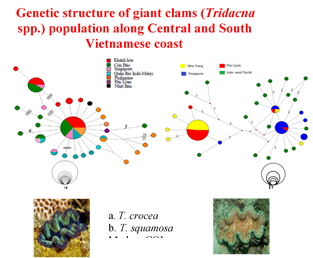|
|
Giant clams have economic value and play an important role in coral reef ecology. However, in recent years, giant clam resources have been declining due to overexploitation. This study investigated the population genetic structure of giant clams (Tridacnae spp.) in South Central and Southern Vietnam’s coast. Analysis of genetic diversity and population structure of two species of giant clams (Tridacna crocea collected in Nha Trang Bay and Con Dao and T. squamosa collected in Nha Trang Bay and Phu Quoc Island) was done based on CO1 mitochondrial DNA. The results showed that populations of T. crocea represented the average diversity with sequence differences between individuals 0-3.5%, 10 haplotypes/30 individuals (haplotype diversity= 0.846) in Nha Trang Bay and sequence differences 0-9.7%, 16 halotypes/28 individuals (haplotype diversity=0.934) in Con Dao. Populations of T. squamosa expressed the low diversity with the genetic sequence differences 0-2.1%, 7 haplotypes/19 individuals (haplotype diversity=0.468) in Nha Trang Bay and the genetic sequence differences 0-1.72%, 5 halotypes/18 individuals in Phu Quoc (haplotype diversity=0.314). Phylogenetic tree did not show the specific population structure of two species from South Central and Southern coast of Vietnam. Simultaneously, populations of two species of giant clams in Vietnam had close relationship with the genetics of giant clam populations collected in some areas of Southeast Asian coast. |
Genetic structure of gaint clams (Tridacna spp.) population along Central and South of Vietnam coast
Related
- Phylogeny of zoonotic parasites in fresh and brackish water fish in Vietnam (21-7-2014 12:12:31)
- Isolation, identification of luminous Vibrio in diseased cultured common seahorse (Hippocampus kuda) (04-8-2014 02:03:24)
- Phylogenetic relationship of giant clams (Tridacna spp.) collected in the South and Central coast of Vietnam (04-8-2014 02:01:42)
- Feeding mode of cone snail (Conus spp.) and phylogenetic relationships (04-8-2014 01:59:46)
Others
- About us (17-7-2014 09:35:40)
- SVM30022GR0249 "Management and restoration mangrove forests in the north of Khanh Hoa province - Toward sustainable landscape" (25-10-2023 09:44:51)
- VINIF.2022.DA00021 "DNA metabarcoding and integrated information database - Implication for Ichthyoplankton survey and fisheries management in Vietnam" (25-10-2023 09:53:54)
- Riverscape Genetics to Inform Natural History of Exploited Fishes in the Lower Mekong River Basin (23-10-2017 11:43:14)

